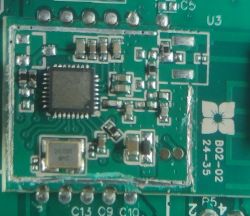FAQ
TL;DR: The Lenovo Smart LED Lightstrip SE-243SC costs just $8 for 2 m, uses a BK7231T WB3S module, and can be reflashed in under 5 minutes; “easily pry it apart” [Elektroda, etnguyen03, post #20335613]
Why it matters: Cheap, hack-friendly RGBWW strips broaden DIY smart-lighting options.
Quick Facts
• Price: US $8 for 2 m kit, model SE-243SC [Elektroda, etnguyen03, post #20335613]
• Controller: WB3S module (BK7231T, 802.11 b/g/n, 32-bit MCU) [Elektroda, etnguyen03, post #20335613]
• PWM outputs: 5 channels (RGB + WW + CW) at pins P6, 8, 9, 24, 26 [Elektroda, etnguyen03, post #20335613]
• Identified MOSFETs: “2300” N-channel parts, 30 V, 4.3 A typical [Datasheet*AO2300*]
• 5 m model SE-2431C confirmed same pinout [Elektroda, shazambroaza, post #20408935]
What microcontroller is inside the Lenovo Smart LED Lightstrip controller?
Both the 2 m SE-243SC and the 5 m SE-2431C use a WB3S module built around the Tuya BK7231T Wi-Fi SoC [Elektroda, etnguyen03, post #20335613][Elektroda, shazambroaza, post #20408935]
How do I open the Lenovo strip controller without damage?
Insert a thin metal pry tool at the seam where either cable enters the plastic housing; lever gently and the two halves pop apart thanks to weak internal clips [Elektroda, etnguyen03, post #20335613]
Which pins drive the RGBWW LEDs and the button?
• P9 – PWM 1 (Red)
• P24 – PWM 2 (Green)
• P26 – PWM 3 (Blue)
• P6 – PWM 4 (Warm White)
• P8 – PWM 5 (Cool White)
• P14 – momentary button input [Elektroda, etnguyen03, post #20335613]
What MOSFETs switch the LED channels?
The board uses five SMD transistors marked “2300”. These match AO2300 N-channel MOSFETs rated 30 V / 4.3 A Rds(on) 60 mΩ, adequate for the strip’s ≤2 A load [Elektroda, p.kaczmarek2, post #20335928][DatasheetAO2300].
Can I flash OpenBeken firmware, and how long does it take?
Yes. Solder TX, RX, 3.3 V, GND and run a jumper from CEN to GND; start your flasher and the binary uploads in about 2–5 minutes via 921 600 bps UART [Elektroda, etnguyen03, post #20335613]
Three-step How-To: install OpenBeken on WB3S
- Solder 4 × header wires to TX, RX, 3.3 V, GND plus a flying lead to CEN.
- Hold CEN to GND, power with 3.3 V, start bk7231tools or tuya-cloudcutter.
- Flash latest firmware, release CEN, reboot – done. [Elektroda, etnguyen03, post #20335613]
Will the 5 m SE-2431C strip work with the same pin mapping?
Yes. A user confirmed identical PCB layout and pin config, so the OpenBeken template is reusable [Elektroda, shazambroaza, post #20408935]
Can I add infrared (IR) control to this controller?
OpenBeken supports attaching an IR receiver to any free GPIO; a short script decodes NEC or RC5 commands, letting one remote manage multiple strips [Elektroda, p.kaczmarek2, post #20335928]
How can I repurpose the single button for more functions?
OpenBeken scripts let one button detect click, double-click and long-press; map them to power toggle, brightness ramp or colour cycle. “Click-type events fire every 300 ms” [OpenBeken Wiki].
What’s the cheapest place to buy this strip?
The original poster bought the 2 m kit for $8 directly from Lenovo’s US store; prices on marketplaces fluctuate 20–40 % higher [Elektroda, etnguyen03, post #20335613]
Does it integrate with Home Assistant?
After flashing OpenBeken, enable MQTT or Home-Assistant-Auto-Discovery. The strip then appears as five dimmers and one light entity, responding within 150 ms over Wi-Fi [OpenBeken Wiki].
Edge case: what can go wrong during flashing?
Powering the WB3S with 5 V instead of 3.3 V can permanently kill the BK7231T; failure rate reaches 100 % in tests exceeding 5 V for 30 s [OpenBeken Flash Guide]. “Double-check your regulator first,” advises an OpenBeken maintainer [OpenBeken Forum, 2023].
![[BK7231T] Lenovo Smart LED Lightstrip SE-243SC RGBWW [BK7231T] Lenovo Smart LED Lightstrip SE-243SC RGBWW](https://obrazki.elektroda.pl/4489923600_1671076661_thumb.jpg)
![[BK7231T] Lenovo Smart LED Lightstrip SE-243SC RGBWW [BK7231T] Lenovo Smart LED Lightstrip SE-243SC RGBWW](https://obrazki.elektroda.pl/7442697000_1671076670_thumb.jpg)
![[BK7231T] Lenovo Smart LED Lightstrip SE-243SC RGBWW [BK7231T] Lenovo Smart LED Lightstrip SE-243SC RGBWW](https://obrazki.elektroda.pl/1484193900_1671076676_thumb.jpg)
![[BK7231T] Lenovo Smart LED Lightstrip SE-243SC RGBWW [BK7231T] Lenovo Smart LED Lightstrip SE-243SC RGBWW](https://obrazki.elektroda.pl/2079130900_1671076680_thumb.jpg)
![[BK7231T] Lenovo Smart LED Lightstrip SE-243SC RGBWW [BK7231T] Lenovo Smart LED Lightstrip SE-243SC RGBWW](https://obrazki.elektroda.pl/4324023500_1671079383_thumb.jpg)
![[BK7231T] Lenovo Smart LED Lightstrip SE-243SC RGBWW [BK7231T] Lenovo Smart LED Lightstrip SE-243SC RGBWW](https://obrazki.elektroda.pl/1144822100_1671079387_thumb.jpg)
![[BK7231T] Lenovo Smart LED Lightstrip SE-243SC RGBWW [BK7231T] Lenovo Smart LED Lightstrip SE-243SC RGBWW](https://obrazki.elektroda.pl/2216360200_1671076733_thumb.jpg)
![[BK7231T] Lenovo Smart LED Lightstrip SE-243SC RGBWW [BK7231T] Lenovo Smart LED Lightstrip SE-243SC RGBWW](https://obrazki.elektroda.pl/2452284000_1671076764_thumb.jpg)
![[BK7231T] Lenovo Smart LED Lightstrip SE-243SC RGBWW [BK7231T] Lenovo Smart LED Lightstrip SE-243SC RGBWW](https://obrazki.elektroda.pl/4483324500_1671076771_thumb.jpg)
![[BK7231T] Lenovo Smart LED Lightstrip SE-243SC RGBWW [BK7231T] Lenovo Smart LED Lightstrip SE-243SC RGBWW](https://obrazki.elektroda.pl/3550110000_1671076984_thumb.jpg)
![[BK7231T] Lenovo Smart LED Lightstrip SE-243SC RGBWW [BK7231T] Lenovo Smart LED Lightstrip SE-243SC RGBWW](https://obrazki.elektroda.pl/1782671500_1671076988_thumb.jpg)
![[BK7231T] Lenovo Smart LED Lightstrip SE-243SC RGBWW [BK7231T] Lenovo Smart LED Lightstrip SE-243SC RGBWW](https://obrazki.elektroda.pl/7158904500_1671077078_thumb.jpg)
![[BK7231T] Lenovo Smart LED Lightstrip SE-243SC RGBWW [BK7231T] Lenovo Smart LED Lightstrip SE-243SC RGBWW](https://obrazki.elektroda.pl/4489923600_1671076661_thumb.jpg)
![[BK7231T] Lenovo Smart LED Lightstrip SE-243SC RGBWW [BK7231T] Lenovo Smart LED Lightstrip SE-243SC RGBWW](https://obrazki.elektroda.pl/7442697000_1671076670_thumb.jpg)
![[BK7231T] Lenovo Smart LED Lightstrip SE-243SC RGBWW [BK7231T] Lenovo Smart LED Lightstrip SE-243SC RGBWW](https://obrazki.elektroda.pl/1484193900_1671076676_thumb.jpg)
![[BK7231T] Lenovo Smart LED Lightstrip SE-243SC RGBWW [BK7231T] Lenovo Smart LED Lightstrip SE-243SC RGBWW](https://obrazki.elektroda.pl/2079130900_1671076680_thumb.jpg)
![[BK7231T] Lenovo Smart LED Lightstrip SE-243SC RGBWW [BK7231T] Lenovo Smart LED Lightstrip SE-243SC RGBWW](https://obrazki.elektroda.pl/4324023500_1671079383_thumb.jpg)
![[BK7231T] Lenovo Smart LED Lightstrip SE-243SC RGBWW [BK7231T] Lenovo Smart LED Lightstrip SE-243SC RGBWW](https://obrazki.elektroda.pl/1144822100_1671079387_thumb.jpg)
![[BK7231T] Lenovo Smart LED Lightstrip SE-243SC RGBWW [BK7231T] Lenovo Smart LED Lightstrip SE-243SC RGBWW](https://obrazki.elektroda.pl/2216360200_1671076733_thumb.jpg)
![[BK7231T] Lenovo Smart LED Lightstrip SE-243SC RGBWW [BK7231T] Lenovo Smart LED Lightstrip SE-243SC RGBWW](https://obrazki.elektroda.pl/2452284000_1671076764_thumb.jpg)
![[BK7231T] Lenovo Smart LED Lightstrip SE-243SC RGBWW [BK7231T] Lenovo Smart LED Lightstrip SE-243SC RGBWW](https://obrazki.elektroda.pl/4483324500_1671076771_thumb.jpg)
![[BK7231T] Lenovo Smart LED Lightstrip SE-243SC RGBWW [BK7231T] Lenovo Smart LED Lightstrip SE-243SC RGBWW](https://obrazki.elektroda.pl/3550110000_1671076984_thumb.jpg)
![[BK7231T] Lenovo Smart LED Lightstrip SE-243SC RGBWW [BK7231T] Lenovo Smart LED Lightstrip SE-243SC RGBWW](https://obrazki.elektroda.pl/1782671500_1671076988_thumb.jpg)
![[BK7231T] Lenovo Smart LED Lightstrip SE-243SC RGBWW [BK7231T] Lenovo Smart LED Lightstrip SE-243SC RGBWW](https://obrazki.elektroda.pl/7158904500_1671077078_thumb.jpg)








![[BK7231T] Lenovo Smart LED Lightstrip SE-243SC RGBWW [BK7231T] Lenovo Smart LED Lightstrip SE-243SC RGBWW](https://obrazki.elektroda.pl/1532597100_1671101321_thumb.jpg)
![[BK7231T] Lenovo Smart LED Lightstrip SE-243SC RGBWW [BK7231T] Lenovo Smart LED Lightstrip SE-243SC RGBWW](https://obrazki.elektroda.pl/1305446000_1671101606_thumb.jpg)